Common Finfish in Mississippi Waters
Red Drum
Sciaenops ocellatus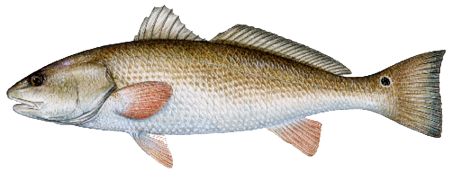
Widely known as Redfish, this species is a favorite of local anglers. These bruisers can get upwards of 30 pounds. Feeding habits are intermediate between their cousins, the bottom-feeding Black Drum and the more surface-feeding Spotted Seatrout. Blue crabs and gold spoons are among the best bait to use for catching Redfish.
Southern Flounder
Paralichthys lethostigma
Flounder are among the best food quality fish Mississippi has to offer and can be caught using bucktail or curl tail jigs during the day or by gigging at night. Flounder are ambush predators so anglers must actively seek them out where they lie and wait.
Sheepshead
Archosargus probatocephalus
Sheepshead are easily identified by its vertical bars and human-like teeth. The species uses its teeth to crush shellfish and crustaceans with protective shells. Anglers are most likely to land a Sheepshead using shrimp or fiddler crabs when fishing near structure. Be aware, they are known for stealing bait off the hook with a very subtle bite.
Spanish Mackerel
Scomberomorus maculatus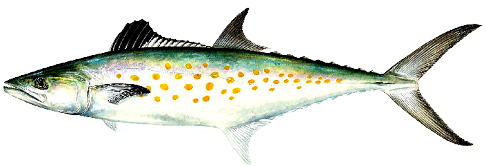
Spanish Mackerel are abundant in the Mississippi Sound from early summer through mid-fall. Caught best on fast-moving, silvery lures, they form the summer staple of the charter fishery. Care should be taken when removing these toothsome critters from the hook.
Spotted Seatrout
Cynoscion nebulosus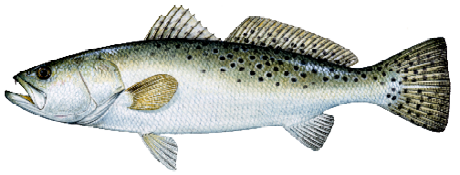
Locally called Speckled Trout, or simply “Speck,” this fish is widely sought in coastal waters Gulf-wide. Specks upwards of 5 pounds are not uncommon, but the average school trout will be around a pound or so. Trout can be caught year-round, but spring and fall are peak fishing times.
Sand Seatrout
Cynoscion arenarius
Locally known as White Trout, this fish is typically smaller than the Speckled Trout and frequently caught inshore. They can be caught using a variety of natural baits or small artificial lures. The species is considered to be better table fare when fresh as it does not freeze as well as other species.
Black Drum
Pogonias cromis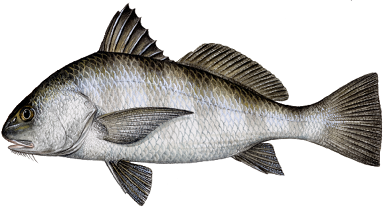
Black Drum, commonly called Puppy Drum, are identifiable by the vertical bars similar to Sheepshead but with a barbelled lower jaw and a mouth aimed downward. The species primarily feeds on crustaceans and shellfish on the sea floor. Be aware that food quality reduces as the species grows larger and they will lose vertical bar coloration as well.
Striped Mullet
Mugil cephalus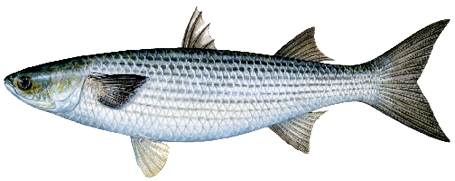
Both Striped and White mullet are called “Biloxi Bacon” along the Mississippi Gulf Coast as this species has historically been brined and smoked by subsistence fishermen. Mullet are typically taken using cast nets. Hook-and-line fishermen can catch these fish with very small hooks and doughball baits.
Cobia
Rachycentron canadum
Alternatively called Lemonfish or Ling, the Cobia is truly a big-game species. Lemonfish up to 100 pounds are caught annually during the spring run. Lemonfish have a decided preference for congregating around buoys, anchored vessels, etc. Live Catfish or Croaker are preferred bait, though a jig or feather might also entice a big lemon into striking.
Red Snapper
Lutjanus campechanus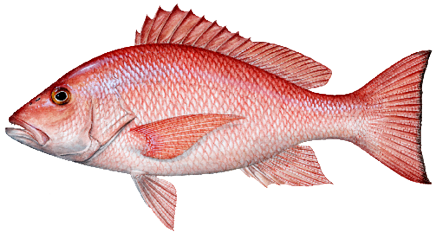
Abundant around the offshore artificial reefs and other bottom structures, the Red Snapper is a delicacy along the Gulf Coast. These brilliantly colored fish are distinguished by their red coloration and reef-dwelling habits. Red Snapper are typically caught on heavy tackle, using natural bait. Please be aware, juveniles may resemble other species with a dark spot below the dorsal rays.
Gray Snapper
Lutjanus griseus
Also called Mangrove Snapper, this small snapper is commonly found inshore congregating around seagrass beds, rocky areas and piers. This species is often found in mixed schools with Pinfish and Pigfish. As they grow larger, they move offshore over hard bottoms and can be caught around artificial reefs.
Tripletail
Lobotes surinamensis
Frequently called Blackfish, Tripletail exhibit truly unique behavior laying on their side near floating items or vertical structures. In order to catch one, present a natural bait under a cork to keep it in the strike zone. The species is among the best table fare fish in Mississippi, but is known to be migratory, arriving in spring and departing in fall.
Illustrations © 1992 and 2009, Diane Rome Peebles

